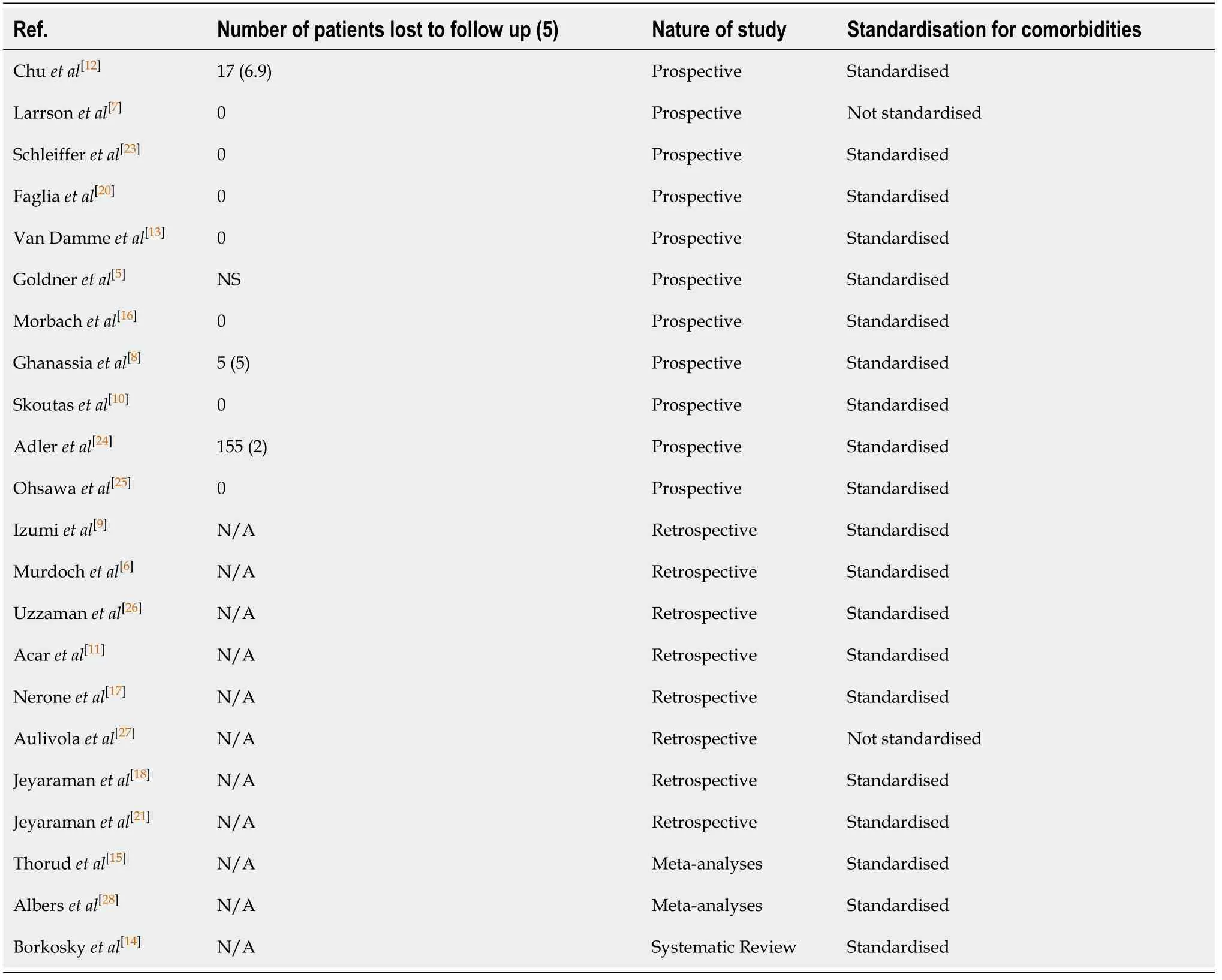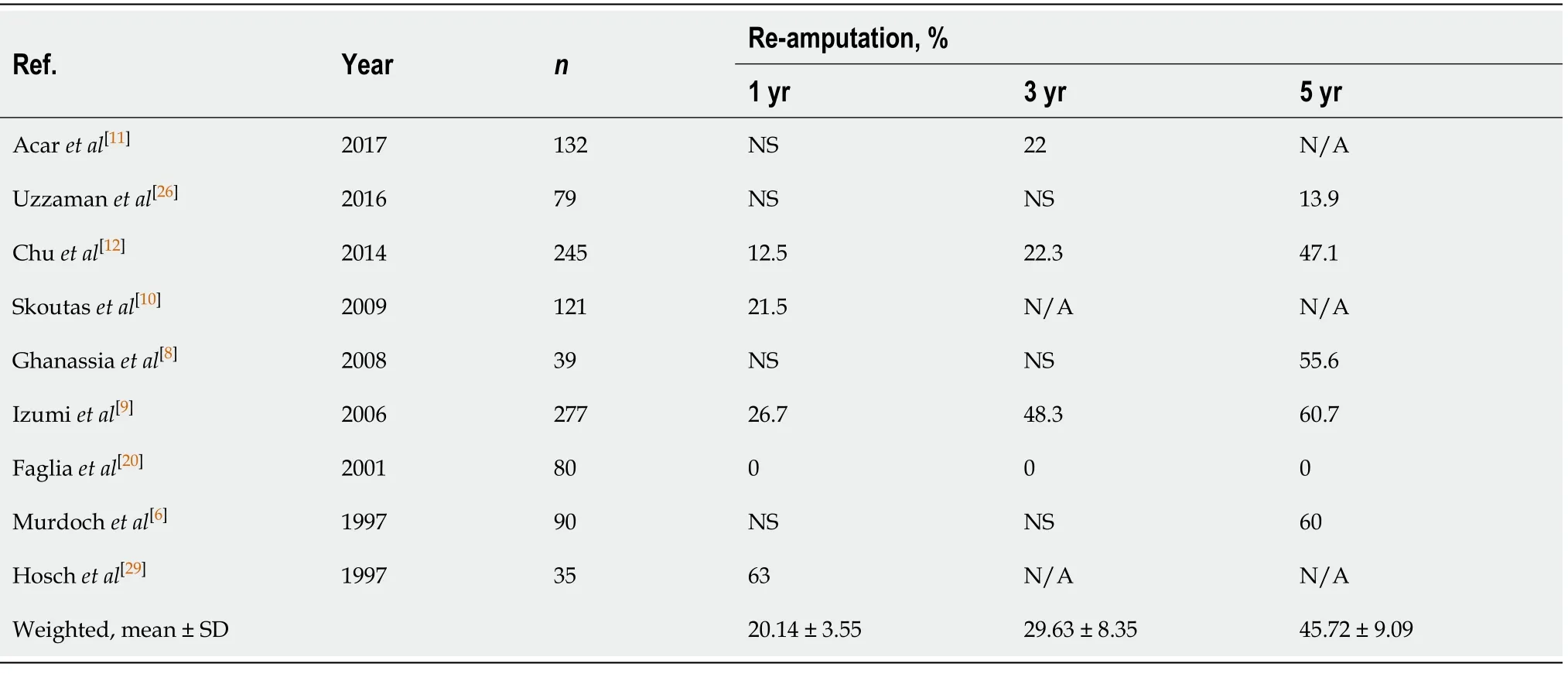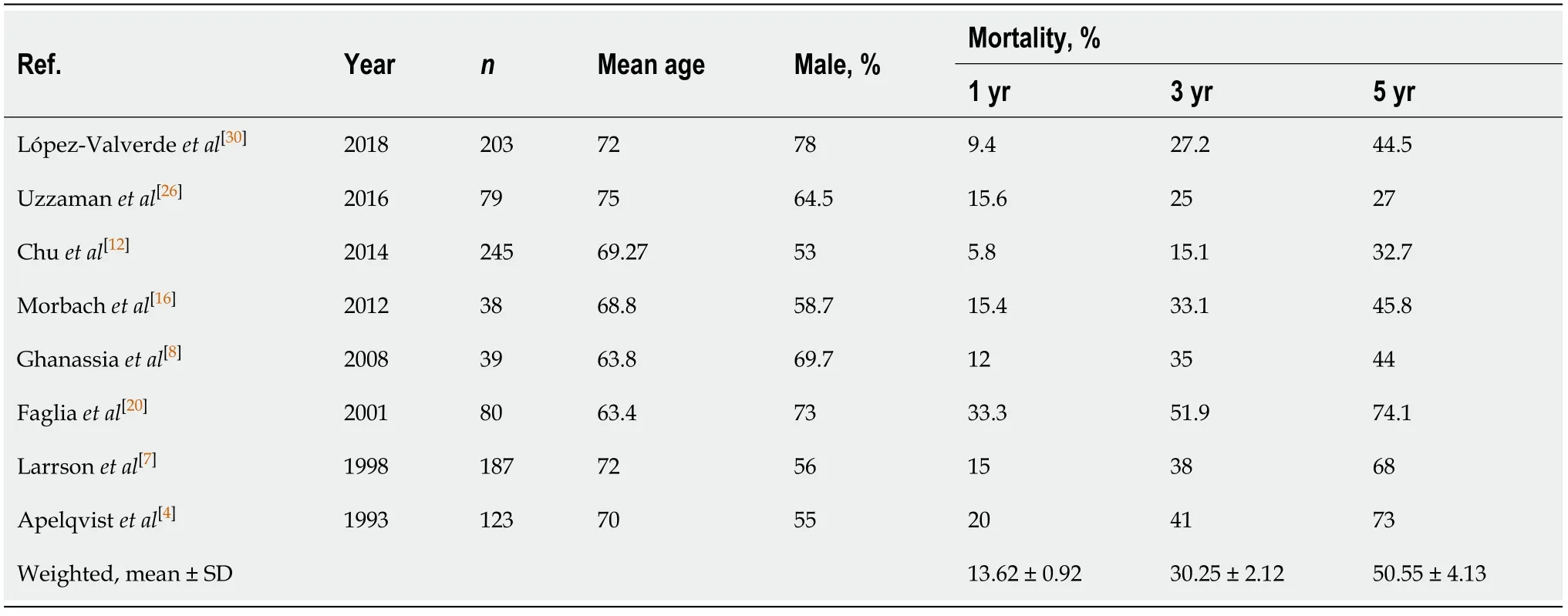Lower extremity amputations and long-term outcomes in diabetic foot ulcers: A systematic review
2021-01-14
Ayeshmanthe Rathnayake, Apoorva Saboo, Usman H Malabu, Usman H Malabu, Department of Medicine, Townsville University Hospital, Townsville 4814, Queensland, Australia
Usman H Malabu, School of Medicine and Dentistry, James Cook University, Townsville 4811,Queensland, Australia
Henrik Falhammar, Department of Endocrinology, Metabolism and Diabetes, Karolinska University Hospital, Stockholm 17176, Sweden
Henrik Falhammar, Department of Molecular Medicine and Surgery, Karolinska Institutet,Stockholm 17176, Sweden
Abstract BACKGROUND Diabetes mellitus causes a large majority of non-traumatic major and minor amputations globally. Patients with diabetes are clinically complex with a multifactorial association between diabetic foot ulcers (DFU) and subsequent lower extremity amputations (LEA). Few studies show the long-term outcomes within the cohort of DFU-associated LEA.AIM To highlight the long-term outcomes of LEA as a result of DFU.METHODS PubMed/MEDLINE and Google Scholar were searched for key terms, “diabetes”,“foot ulcers”, “amputations” and “outcomes”. Outcomes such as mortality, reamputation, re-ulceration and functional impact were recorded. Peer-reviewed studies with adult patients who had DFU, subsequent amputation and follow up of at least 1 year were included. Non-English language articles or studies involving children were excluded.RESULTS A total of 22 publications with a total of 2334 patients were selected against the inclusion criteria for review. The weighted mean of re-amputation was 20.14%,29.63% and 45.72% at 1, 3 and 5 years respectively. The weighted mean of mortality at 1, 3 and 5 years were 13.62%, 30.25% and 50.55% respectively with significantly higher rates associated with major amputation, re-amputation and ischemic cardiomyopathy.CONCLUSION Previous LEA, level of the LEA and patient comorbidities were significant risk factors contributing to re-ulceration, re-amputation, mortality and depreciated functional status.
Key Words:Lower extremity amputations; Long-term outcomes; Diabetic foot ulcers;Quality of life; Re-amputation; Diabetes
INTRODUCTION
Diabetes mellitus is a leading cause for non-traumatic major and minor amputations worldwide. The global diabetes prevalence is expected to rise to 10.2% by 2030,reflecting a considerable health and financial burden across the world due to its recognised aetiology in lower extremity amputations (LEA)[1]. The combination of peripheral neuropathy and vascular disease gives rise to diabetic foot ulcers (DFU)subsequently leading to a higher rate of LEA. LEA is defined as surgical removal of bones and soft tissue by transecting at any level of the lower extremity and can be classified into minor and major amputation. The globally accepted definition of minor amputation is below ankle joint encompassing forefoot and toe while major amputations are at or proximal to the ankle joint such as below or above knee amputation.
The associated immunosuppression as well as impaired blood flow to DFU make conservative treatment with antibiotics difficult and usually mandate extensive,repeated debridement or eventual amputation. Patients with diabetes have a varied,yet overall increased risk of LEA with an incidence of 50-500 per 100000[2]. The shortand long-term outcomes as a result of LEA are profound, as patients with diabetes often have complex comorbidities and socioeconomic backgrounds. Short-term outcomes following LEA are poor, with early post-operatively mortality up to 22%[3].There is currently no systematic review nor meta-analysis published in this field.
The objective of this systematic review and meta-analysis was to elucidate the longterm outcomes in diabetic patients who have LEA as a result of an ulcer. Outcomes such as mortality, re-amputation, re-ulceration and functional return are discussed with an emphasis of associated risk factors.
MATERIALS AND METHODS
The authors performed a systematic review of electronic databases and peer-reviewed sources including PubMed/MEDLINE up to March 25, 2020. Key search terms“Diabetes”, “Foot Ulcers”, “Amputations” and “Outcomes” were used and the authors hand searched each identified manuscript for pertinent references. The inclusion criteria were as follows: (1) Age > 18 years; (2) Presence of DFU prior to undergoing an amputation; and (3) Outcomes measured at longer than at least 12 mo. The exclusion criteria was limited to studies relating to paediatric patients. Only English language studies with original data were included with no restriction on publication date.Duplicate results were excluded. Each study was assessed for selection by two individual authors with a plan for escalation to corresponding authors, should there be a disagreement. No studies required further consensus. Statistical analysis looking at weighted mean age, rates of mortality at 1, 3 and 5 years and re-amputation were calculated. Individual studies were examined for bias, in particular, selection, attrition and recall bias. Significant loss to follow up, degree of heterogeneity and presence of confounding factors were examined. The PRISMA 2009 Checklist was followed. No conflict of interests are declared with no external funding sought for this study.
RESULTS
Key search terms yielded a total of 125 results of which 22 publications were selected against the inclusion and exclusion criteria for review. Of the selected studies, 11 studies were prospective, 8 retrospective, 3 systematic review and meta-analyses(Table 1). Overall, the majority of selected articles were level III evidence but ranged from level II-V and no randomized controlled trials were found. Sixteen of the 18 studies conducted standardisation of the patient cohort with regards to co-morbidities.In the 9 prospective studies, only three studies had any loss of follow up in patients(range 5%-20%).
Rates of re-ulceration were reported to be higher in patients with history of LEA and DFU compared to conservative management in both ipsilateral and contralateral limbs. The weighted mean was calculated for both re-amputation and mortality. A total of 9 articles reported rates of re-amputation of which only 2 articles specified rates at 1, 3 and 5 years. With the exclusion of 2 publications, all articles were published after 2001 and the calculated weighted mean of re-amputation was 20.14%,29.63% and 45.72% at 1, 3 and 5 years respectively (Table 2). A total of 8 articles specify mortality outcomes at 1, 3 and 5 years, of which, only 2 articles were published prior to 2001 (Table 3). The cumulative total of 994 patients found a mean age of 70.2 years and exhibited a male predominance. The weighted mean mortality at 1, 3 and 5 years were 13.62%, 30.25% and 50.55% respectively and were only calculated using the studies which specified each interval's long-term outcome.
DISCUSSION
There is a paucity of data pertaining to long-term outcomes of patients with DFUassociated LEA. Few studies exceed 5 years with the longest study assessing outcomes just over 10 years. The main outcomes of this systematic review and meta-analysis found a weighted mean of mortality at 1, 3 and 5 years were 13.62%, 30.25% and 50.55% respectively and weighted mean of re-amputation at 1, 3 and 5 years were 20.14%, 29.63% and 45.72% respectively. Major amputation was found to be a negative prognostic factor for return to activities of daily living.
Re-ulceration
Patients with a previous LEA for DFU have a higher risk of re-ulceration than patients undergoing conservative treatment for DFU. In a 4-year follow-up study, 40% of patients with previous LEA had re-ulceration at 1 year compared to 30% of the non-LEA group. At the 3 and 5-year mark, the ulcer recurrence was 70% and 75% in the LEA group compared to 52% and 60% in the non-LEA group[4]. Following LEA, there is a high risk of re-ulceration of both the ipsilateral and contralateral limb with the former being higher. In a 5-year follow-up study of 245 patients who had undergone toe amputation for DFU, the cumulative incidence of a new foot ulcer at 1,3 and 5 years was 27.3%, 57.2% and 74.4% respectively. The rate of ulceration in the contralateral limb has been shown to be as high as 23%[5].
Re-amputation
Previous LEA is an important, independent risk factor for further amputations. The earliest studies in the late 1990s examining re-amputations in patients involved rates as high as 60% over 10 years in 90 patients with a Swedish study of 189 patients reporting re-amputation rates at 14%, 30% and 49% at years 1, 3 and 5 after the index LEA[6,7].

Table 1 Follow-up, nature, and presence of standardisation in selected studies
More recently, in a study of 39 patients over 6.5 years, the re-amputation rate remained high at 55.6%[8]. This high rate was also observed over time in another study of 277 patients over 10 years where re-amputation at 1, 3 and 5 years was 26.7%, 48.3%and 60.7%[9]. Other studies show a lower re-amputation rate. A re-amputation rate of 21.5% in a study of 121 patients , 16.7% in 132 patients following DFU-related LEA and 12.5%, 22.3% and 47.1% in 245 patients at 1, 3 and 5 years[10-12].
There is conflicting evidence regarding the role of the index LEA in the risk of subsequent re-amputation. Murdochet al[6]in the 1990s first illustrated that a large proportion of patients with an LEA at the level of the great toe or ray amputation received a higher-level amputation in the first 12 mo[6]. In 146 patients over a 5-year follow up period, a higher rate of re-amputation was observed in primary toe compared to a more proximal forefoot index LEA (28%vs24%)[13].
A systematic review conducted by Borkoskyet al[14]of 435 index ray amputations showed a re-amputation incidence of 19.8% over a mean follow-up of 26 mo. In response to this high rate of re-amputation, Throudet al[15]assessed the viability of a more proximal transmetatarsal amputation. A higher rate of 29.7% was observed in this systematic review of 1453 patients. The most statistically significant difference,however, was seen in 121 patients assessed by Skoutaset al[10]In this study with a follow-up of 18 mo, re-amputation rate following a toe and ray amputation were significantly higher compared to an index major LEA at all 1, 3 and 5 years. Overall,the rate of ipsilateral re-amputation significantly reduced by 34% as the level of the original LEA went higher.
However, the Swedish study in 1998 showed no difference in rate of re-amputation following an index major or minor LEA[7]. Similarly, in another study of 247 patients,there was no statistical difference in re-amputation rate regardless of the nature ofindex LEA in the follow up period of 10 years[16]. With regards to contralateral reamputation, the level of index LEA was also not statistically significant. The effect of the level of index LEA on subsequent re-amputation can be extremely useful in clinical decision making and have a significant effect on patient outcomes. Larger cohorts are needed to establish a meaningful association or lack thereof between index level LEA and re-amputation. In addition, recording the time of subsequent amputations may provide further insight into differences between type of index amputation and the interval time to re-amputation.

Table 2 Re-amputation at 1, 3 and 5 years in patients who previously had had a lower extremity amputation due to diabetes foot ulcer

Table 3 Mortality at 1, 3 and 5 years in patients who previously had had a lower extremity amputation due to diabetes foot ulcer
The presence and severity of peripheral arterial disease (PAD) was also seen as a significant risk factor in the need for re-amputation. In a study of 163 patients with an index DFU-associated LEA, rates of re-amputation were significantly related to the presence and severity of PAD[17]. Over a mean follow-up of 3.65 years, these patients either had a subsequent major or minor re-amputation. A higher proportion of the major group (111 patients) had PAD compared to in the minor (52 patients) group(71.15%vs22.23%;P< 0.001). Furthermore, there was a significantly decreased interval to a major amputation if PAD was present and whether it was mild to moderate (1.62 years) or severe (1.53 years) than if no PAD (3.24 years).
An Australian study done by Jeyaramanet al[18]of 513 patients with DFU with a mean follow-up of 5.8 years showed prior LEA was an independent factor to subsequent re-amputation. In the 263 patients who had a LEA, 85 (32.3%) had a prior LEA which was statistically significant. The odds ratio (OR) for any subsequent LEA was 4.49 (95% confidence interval 1.69-11.9), further broken down into 4.84 in the minor group and 3.06 for a subsequent major LEA.
Mortality
We found a total of 8 articles which had reported on up to 5-year mortality in patients undergoing major and minor amputations secondary to DFU with interval data at 1, 3 and 5 years (Table 2). The weighted mean mortality at 1, 3 and 5 years were 13.62%,30.25% and 50.55% respectively (Table 3). Furthermore, six other studies illustrated similar mortality at varied follow-up periods ranging from 1 to 10 years. Comparable 3-year mortality was reported by Neroneet al[17]and Ramseyet al[19]of 28.85% and 28%respectively.
Chuet al[12](2014) is the largest study to date which observed 245 patients for 5 years post DFU-associated LEA and reported the cumulative mortality of 5.8%, 15.1% and 32.7% at 1, 3 and 5 years respectively. The overall all-cause mortality in this study was 37.8% with an average survival time for deceased patients of 3.8 years and a longer duration of survival in females (4.1 years). Cause of death varied including footrelated deaths (25.7%), renal failure (22.9%), heart failure (18.6%) and malignancy(17.1%). Age > 70, poor glycemic control (HbA1c > 9,P< 0.01), critical limb ischemia(OR = 5.60; 95%CI: 2.41-12.98,P< 0.01), diabetic nephropathy (OR = 3.86; 95%CI: 1.65-9.03;P< 0.01), level of amputation and re-amputation were identified as independent risk factors for impaired wound healing, re-ulceration, re-amputation and mortality.
The level and previous history of amputation were observed as risk factors. In Larsonet al[7], a statistically significant higher mortality was observed following major index LEA than minor. Overall, mortality rates at 1, 3 and 5 year were also higher than previous studies (15%, 38% and 68%) respectively. Apelqvistet al[4](1993) reported a higher long-term (1, 3 and 5 year) mortality rate among patients with a previous amputation from a diabetic foot ulcer compared to new, primary amputation (20%,41%, 73%vs8%, 27%, 42%).
Fagliaet al[20]reported higher rates of mortality at each interval 33.3%, 51.9% and 74% of which ischemic cardiomyopathy was identified as the most frequent cause of death. A large proportion (47%) of this study population were affected with ischemic cardiomyopathy unlike a much smaller percentage reported in previous studies.Subsequently, it is an important independent patient characteristic to consider when assessing risk in patients undergoing LEA with DFU given there were no reamputations in this cohort. Chuet al[12]also reported ischemic heart disease (HR = 1.6,95%CI: 1.1-2.4) in addition to deeper ulcers with bone involvement (HR = 1.5, 95%CI:1.2-1.7) as positive predictors for death.
In the Australian study of 513 patients conducted by Jeyaramanet al[21], there were 199 deaths during a mean follow-up of 5.8 years. The 5-year mortality was recorded at 24.6%, increasing to 45.4% at the 10-year mark. Of note, these patients died at an average age of 64.6 years, significantly lower than the Australian average of 80.4 years males and 84.5 years in females.
The 14 studies describing mortality post DFU-associated LEA fall within comparable ranges, however, some variability noted is due to smaller cohort sizes and presence of ischemic cardiomyopathy in particular.
Effect on the activities of daily living
There is limited data available describing the functional outcomes in patients undergoing DFU-associated LEA. Although such a cohort of patients invariably have complex socioeconomic backgrounds and variable demographics, our search yielded two studies with relatively objective measures of functional status.
Re-amputation has been noted to play an important role in return to functional status in long-term studies. Chuet al[12]examined the long-term impact on activities of daily living based on Barthel Index Classification (BIC). The Barthel Index of Activities of Daily Living is a simple tool measuring functional independence[22]. It comprises 10 separate sections of assessment with a total score of 100 and can be easily administered by health-care professionals. This is a world-wide accepted tool and has been utilized in a large number of studies. Chuet al[12]reported 31.9% of patients having moderate to severe dysfunction, assessed by the BIC, of the activities of daily living at 5 years.Furthermore, 77.9% of these patients had undergone re-amputation and 54.2% had died. In contrast, the remaining 126 patients considered to have no or mild dysfunction of activities of daily living had lower rates of re-amputation (34.9%) and mortality (30.2%). Of note, there was a higher ratio of major to minor amputations in the moderate to severe dysfunction group compared to no or mild dysfunction group[24 (major):22 (minor)vs12 (major):32 (minor)].
Van Dammeet al[13]reported that only 63% of the major amputations (n= 143)regained an autonomic walking capability with their prosthesis suggesting poor functional recovery after major amputations undertaken for DFUs. As well as functional status, an important measure of lifestyle change in hospitalized patients is discharge destination. Larson Jet al[7]reported a statistically significant difference in discharge following minor and major patients in 187 patients. In the minor group, 93%of patients returned home compared to only 62% in the major group (P< 0.001).Patients who underwent minor amputations also had a higher chance of satisfactory return to baseline function. In patients with a considerable walking capacity (> 1 km)prior to amputation, 49 of 68 patients (72.1%) who had a minor amputation regained this capacity compared to only 5 of the 28 patients (17.8%) with major amputation (P<0.001).
The present study has several limitations. As this systematic review examined studies from a myriad of social backgrounds with variable demographics,heterogeneity in the studied population could not be avoided. The variable duration of follow-up also added to this heterogeneity, adding to the challenge to derive conclusions to specific groups of patients. Approximately 50% of the studies in our systematic review were retrospective, predisposing outcomes to historical or recall bias. Patients lost to follow-up could also potentially underestimate adverse outcomes leaning from the hypothesis of selection bias that such patients are less likely to be compliant with glucose monitoring. Similarly, non-participation at the start in prospective studies also represents a gap in outcomes from that particular cohort. The indications for re-amputation were not clearly noted in the examined studies making the cause-and-effect relationship from a previous amputation less reliable. Reporting of comorbidities was also patchy across studies making standardised conclusions difficult.
In conclusion, there was a significantly higher degree of re-amputation and mortality in the long-term in the population who undergo amputations due to diabetic foot ulcers. There was also a significant impact on the overall functional status of patients and quality of life. This systematic review and meta-analysis affirms the need for regular review and follow-up in this vulnerable group owing to this high risk of adverse outcomes. The effect of comorbidities was not clear and therefore further studies in a subset of patients with particular coexisting illnesses such as chronic kidney failure or peripheral vascular disease are needed.
ARTICLE HIGHLIGHTS
Research background
There is no previous systematic review and meta-analysis undertaken particularly in long-term outcomes of patients who undergo lower limb amputation (LEA) for diabetic foot ulcers (DFU). Although multiple studies describing short-term outcomes under 12 mo are available, conclusions for long-term outcomes are needed to support clinical decision-making in relation to patient characteristics.
Research motivation
Since DFU account for significant complications in patients with diabetes mellitus, the assessment of their long-term outcomes is necessary. The review of long-term outcomes following LEA is essential for decision-making and risk stratification for individual patients.
Research objectives
The aim of this paper is to establish a systematic review of long-term studies undertaken in patients who underwent LEA as a treatment modality for DFU. The focus of the review is on re-ulceration, re-amputation and the impact on the quality of life of patients. These parameters, particularly in the longer-term setting pave way for future research in larger cohorts, various demographics and relation to co-morbidities.
Research methods
Key search terms such as “diabetes”, “foot ulcers”, “amputations” and “outcomes”were searched on PubMed/MEDLINE and Google Scholar. A follow-up of 12 mo, age> 18 and LEA post DFU were inclusion criteria. Paediatric patients were excluded.Two co-authors selected studies based on the inclusion criteria and search results were limited to the English language. A total of 22 publications with a total of 2334 patients were selected. There were no randomised controlled trials with the majority of studies being cohort studies.
Research results
Our results show a significant re-amputation and mortality rates at 1, 3 and 5 years after initial LEA for DFU. A positive correlation was also noted for previous other major amputation and ischemic cardiomyopathy. We attempted to standardise patients for co-morbidities, however, this was not possible in a minority of studies.Therefore, future research should be aimed at delineating the nature of association between LEA post DFU and patient co-morbidities.
Research conclusions
Our systematic review and meta-analyses support our key hypotheses of a significant positive association of re-amputation, mortality and quality of life in our set of patients on a long-term basis. The pivotal purpose of this study is data to assist patient selection and decision-making. It also supports the uniformity of similar rates of reamputation and mortality in various studies globally with no significant outliers.
Research perspectives
Future research should be aimed at assessing the significance of co-morbidities on patients with DFU undergoing LEA. This will allow a closer risk stratification and aid patient decision-making individualised to their situation. In addition to this, as outcomes in diabetes mellitus often depend on patient compliance influenced by their socio-economic or cultural backgrounds, further studies are needed in these groups.The best methods for future studies would be larger, multi-center prospective studies.
